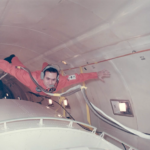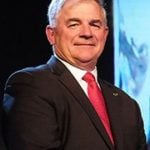Space Awareness
Remembering the First Astronauts of Apollo
Written by: Space Foundation Editorial Team
The Space Foundation's year-long commemoration of the Apollo missions continues with this article written by Space Foundation Senior Analyst John Holst, remembering the Apollo 1 astronauts.
by John Holst, Space Foundation Senior Analyst
In between September's mission success of Gemini XI and the last scheduled Gemini mission in November 1966, NASA, in October, brought more public focus on the astronauts who would be flying the first mission of the Apollo project.
Initially announced as the prime crew for the first Apollo Earth-orbiting mission in March 1966, NASA reiterated the prime crew selection for the Apollo-Saturn 204 (AS-204) mission in mid-October of the same year. Three men were identified as the first astronauts manning an Apollo mission -- Virgil I. "Gus" Grissom, Edward H. White II, and Roger B. Chaffee. The crew would fly AS-204 sometime in early 1967, but upon NASA's 1966 announcement, the world instantly paid attention to the three individuals who were first in line to fly the Apollo missions.
Of the three astronauts, Roger Chaffee was the newest member to the NASA family. He was a U.S. Navy lieutenant commander at the time of his selection. He joined that service initially as a Navy ROTC cadet during his college years, then became an officer in the Navy straight out of college in 1957.
Chaffee had flown more than 2,000 hours as a pilot during his time in the U.S. Navy. He also continued his studies in engineering, so that six years after his Navy enlistment, Chaffee was among the third wave of astronauts selected to join NASA's manned spaceflight programs. By the time he was selected for AS-204 in March 1966, he had yet to fly a NASA mission.
Chaffee's inexperience with NASA missions was one of the reasons Gus Grissom was assigned as AS-204's command pilot. A U.S. Air Force Lieutenant Colonel, Grissom started in the U.S. Army Air Forces as a cadet in 1944. However, the Second World War ended before he could earn his wings, and he was discharged.
Grissom worked while he went to college, and his wife, Betty, worked to support them, as well. He eventually graduated with an engineering degree from the same school that Chaffee had attended, Purdue University. Grissom subsequently earned his pilot's wings as a commissioned officer in the United States Air Force in 1951.
By the time Grissom joined NASA's astronaut corps in 1959, he had 4,600 hours of flying time under his belt, including combat flying in the Korean War. Grissom was one of the first seven NASA astronauts selected to fly into space. When NASA selected him for AS-204, he had already flown one Mercury mission, gaining fame as the second American in space. He also commanded the first Gemini mission, Molly Brown (known as GT-3).
He helped in the design of the Gemini capsule, so much so that people nicknamed it the "Gusmobile." Grissom's involvement with the Gemini capsule design and systems also made him a prime candidate to supervise Gemini training of the second wave of NASA astronauts. Ed White was among that second group.
Ed White had attended and graduated from West Point. After White graduated, he became a commissioned officer in the United States Air Force and logged more than 3,000 hours in the service as a pilot. Some of that time he was stationed overseas, in Germany. During his tours in the Air Force, he earned a master's degree in engineering and flew as a test pilot. In September 1962, NASA selected White to join the astronaut corps.
As a NASA astronaut, White was probably most famous for his first space mission, Gemini IV. He was the first American to conduct a spacewalk for 21 minutes, a session critical for NASA's understanding of how humans would work in space and on the Moon's surface. It was his performance during his spacewalk in the Gemini IV mission that prompted his selection as Senior Pilot for AS-204.
With Mercury accomplished, and Gemini nearly completed, NASA and its astronauts were ready to apply the lessons learned from those two already ambitious projects to an even more ambitious series of missions: Apollo. It was almost time for the astronauts of Mercury, Gemini, and NASA to become the astronauts of Apollo. Apollo's goal? The Moon.


